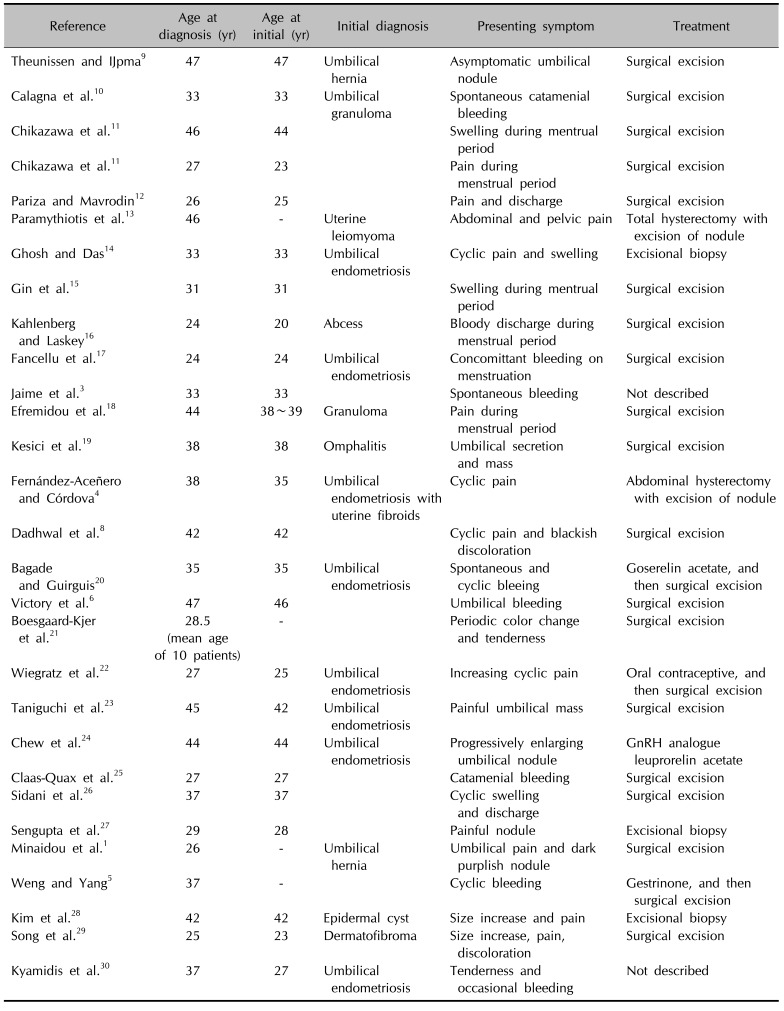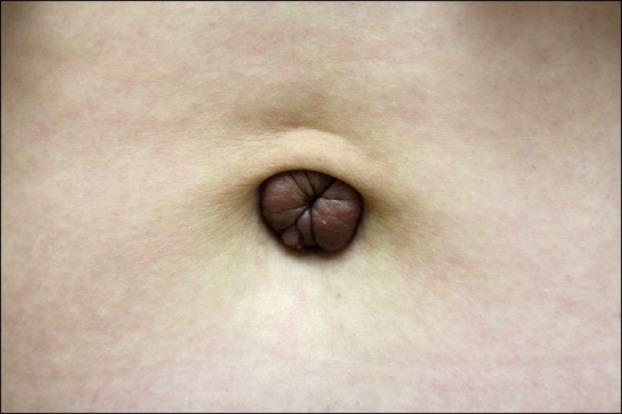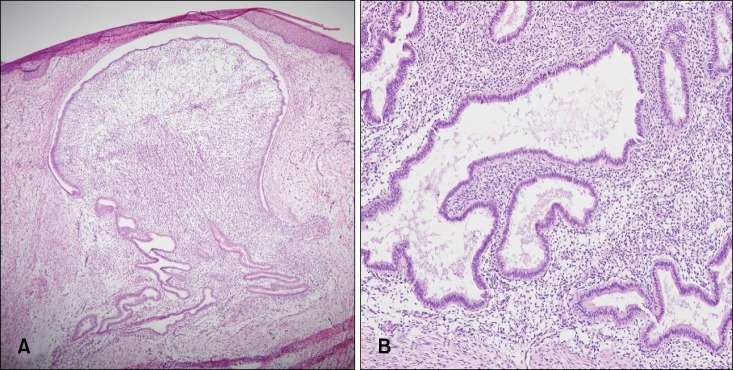1. Minaidou E, Polymeris A, Vassiliou J, Kondi-Paphiti A, Karoutsou E, Katafygiotis P, et al. Primary umbilical endometriosis: case report and literature review. Clin Exp Obstet Gynecol. 2012; 39:562–564. PMID:
23444772.
2. Yuen JS, Chow PK, Koong HN, Ho JM, Girija R. Unusual sites (thorax and umbilical hernial sac) of endometriosis. J R Coll Surg Edinb. 2001; 46:313–315. PMID:
11697703.
3. Jaime TJ, Jaime TJ, Ormiga P, Leal F, Nogueira OM, Rodrigues N. Umbilical endometriosis: report of a case and its dermoscopic features. An Bras Dermatol. 2013; 88:121–124. PMID:
23539017.

4. Fernández-Aceñero MJ, Córdova S. Cutaneous endometriosis: review of 15 cases diagnosed at a single institution. Arch Gynecol Obstet. 2011; 283:1041–1044. PMID:
20422419.

5. Weng CS, Yang YC. Images in clinical medicine. Villar's nodule--umbilical endometriosis. N Engl J Med. 2011; 364:e45. PMID:
21612465.
6. Victory R, Diamond MP, Johns DA. Villar's nodule: a case report and systematic literature review of endometriosis externa of the umbilicus. J Minim Invasive Gynecol. 2007; 14:23–32. PMID:
17218225.

7. Groothuis PG, Koks CA, de Goeij AF, Dunselman GA, Arends JW, Evers JL. Adhesion of human endometrium to the epithelial lining and extracellular matrix of amnion in vitro: an electron microscopic study. Hum Reprod. 1998; 13:2275–2281. PMID:
9756310.

8. Dadhwal V, Gupta B, Dasgupta C, Shende U, Deka D. Primary umbilical endometriosis: a rare entity. Arch Gynecol Obstet. 2011; 283(Suppl 1):119–120. PMID:
21170542.

9. Theunissen CI, IJpma FF. Primary umbilical endometriosis: a cause of a painful umbilical nodule. J Surg Case Rep. 2015; 2015:rjv025. PMID:
25786440.

10. Calagna G, Perino A, Chianetta D, Vinti D, Triolo MM, Rimi C, et al. Primary umbilical endometrioma: analyzing the pathogenesis of endometriosis from an unusual localization. Taiwan J Obstet Gynecol. 2015; 54:306–312. PMID:
26166347.

11. Chikazawa K, Mitsushita J, Netsu S, Konno R. Surgical excision of umbilical endometriotic lesions with laparoscopic pelvic observation is the way to treat umbilical endometriosis. Asian J Endosc Surg. 2014; 7:320–322. PMID:
25354378.

12. Pariza G, Mavrodin CI. Primary umbilical endometriosis (Villar's nodule)-case study, literature revision. Chirurgia (Bucur). 2014; 109:546–549. PMID:
25149622.
13. Paramythiotis D, Stavrou G, Panidis S, Panagiotou D, Chatzopoulos K, Papadopoulos VN, et al. Concurrent appendiceal and umbilical endometriosis: a case report and review of the literature. J Med Case Rep. 2014; 8:258. PMID:
25052818.

14. Ghosh A, Das S. Primary umbilical endometriosis: a case report and review of literature. Arch Gynecol Obstet. 2014; 290:807–809. PMID:
24930115.

15. Gin TJ, Gin AD, Gin D, Pham A, Cahill J. Spontaneous cutaneous endometriosis of the umbilicus. Case Rep Dermatol. 2013; 5:368–372. PMID:
24516408.

16. Kahlenberg LK, Laskey S. Primary umbilical endometriosis presenting as umbilical drainage in a nulliparous and surgically naive young woman. Am J Emerg Med. 2014; 32:692.e1–692.e2.

17. Fancellu A, Pinna A, Manca A, Capobianco G, Porcu A. Primary umbilical endometriosis. Case report and discussion on management options. Int J Surg Case Rep. 2013; 4:1145–1148. PMID:
24291679.

18. Efremidou EI, Kouklakis G, Mitrakas A, Liratzopoulos N, Polychronidis ACh. Primary umbilical endometrioma: a rare case of spontaneous abdominal wall endometriosis. Int J Gen Med. 2012; 5:999–1002. PMID:
23271917.

19. Kesici U, Yenisolak A, Kesici S, Siviloglu C. Primary cutaneous umbilical endometriosis. Med Arch. 2012; 66:353–354. PMID:
23097979.

20. Bagade PV, Guirguis MM. Menstruating from the umbilicus as a rare case of primary umbilical endometriosis: a case report. J Med Case Rep. 2009; 3:9326. PMID:
20062755.

21. Boesgaard-Kjer D, Boesgaard-Kjer D, Kjer JJ. Primary umbilical endometriosis (PUE). Eur J Obstet Gynecol Reprod Biol. 2017; 209:44–45. PMID:
27374811.

22. Wiegratz I, Kissler S, Engels K, Strey C, Kaufmann M. Umbilical endometriosis in pregnancy without previous surgery. Fertil Steril. 2008; 90:199.e17–199.e20.

23. Taniguchi F, Hirakawa E, Azuma Y, Uejima C, Ashida K, Harada T. Primary umbilical endometriosis: unusual and rare clinical presentation. Case Rep Obstet Gynecol. 2016; 2016:9302376. PMID:
27242939.

24. Chew KT, Norsaadah S, Suraya A, Hing EY, Ani Amelia Z, Nor Azlin MI, et al. Primary umbilical endometriosis successfully treated with dienogest. Horm Mol Biol Clin Investig. 2017; 29:67–69.
25. Claas-Quax MJ, Ooft ML, Hoogwater FJ, Veersema S. Primary umbilical endometriosis. Eur J Obstet Gynecol Reprod Biol. 2015; 194:260–261. PMID:
26344784.

26. Sidani MS, Khalil AM, Tawil AN, El-Hajj MI, Seoud MA. Primary umbilical endometriosis. Clin Exp Obstet Gynecol. 2002; 29:40–41. PMID:
12013091.
27. Sengupta M, Naskar A, Gon S, Majumdar B. Villar's nodule. Online J Health Allied Sci. 2011; 10:19.
28. Kim SH, Park SJ, Lee DY, Lee ES. A case of cutaneous endometriosis. Korean J Dermatol. 2002; 40:100–102.
29. Song WK, Park HJ, Kim YC, Cinn YW. A case of cutaneous endometriosis. Korean J Dermatol. 2000; 38:999–1001.
30. Kyamidis K, Lora V, Kanitakis J. Spontaneous cutaneous umbilical endometriosis: report of a new case with immunohistochemical study and literature review. Dermatol Online J. 2011; 17:5.

31. Purvis RS, Tyring SK. Cutaneous and subcutaneous endometriosis. Surgical and hormonal therapy. J Dermatol Surg Oncol. 1994; 20:693–695. PMID:
7930017.





 PDF
PDF ePub
ePub Citation
Citation Print
Print




 XML Download
XML Download